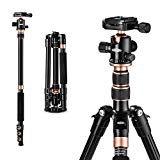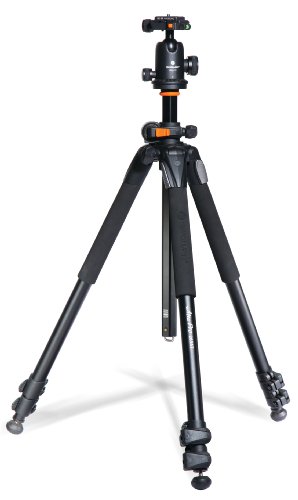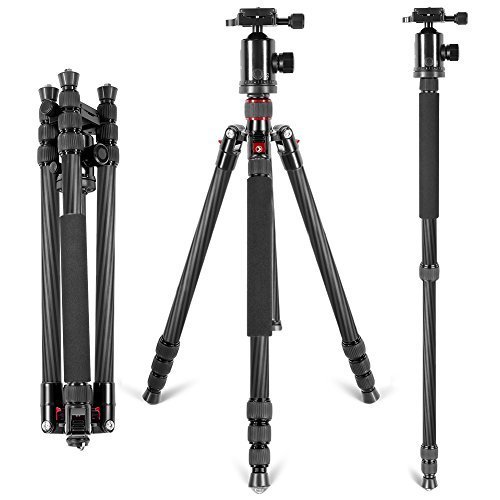Top 5 Best Tripod for Filming Hunts | Reviews of 2021
Our experts like to share product recommendations with you and hope you like them! Just to make you aware, CatchThemEasy may collect a small share of sales or other compensation from the links on this page.

Filming hunts have become even more popular over the past few years simply because of how easy and fast it is to upload your video to the likes of YouTube or Facebook.
There are different ways that you can record your hunts such as attaching a camera to a bow or rifle, a tree arm or setting up a freestanding tripod. The right option for you will depend on how you intend to hunt and what it is you're hunting, as filming a turkey hunt is much different from trying to get a good shot of some whitetail deer.
If a freestanding tripod is an option you are considering for attaching your camera to, but not sure which model to go for, then don't worry as we've picked our best 5 tripods for filming your hunts. Let's compare them and see what might be an option for you below.
Top 5 Rated Models Comparison Table
Image | Tripod | Max Height | Price |
|---|---|---|---|
Editors Choice | 55.5" | ||
72.24” | |||
68.125" | |||
63" | |||
64" |
Reviews of The Best Tripods for Filming Hunts
Cheap, light and durable, this tripod is our Top Pick for the Best Tripod for Filming Hunts. It’s not as a tall as many others, standing only 55” tall, but makes up for it with a compact size and ultralight weight; it comes in at only 2.89 pounds while folding down to a barely-there 14”. That’s some of the lightest you’ll find in a tripod and comes in very handy when hauling it around all day.
The legs are made from “high-density” aluminum alloy, which packs plenty of strength in a small package; they fold up neatly and compactly while providing a sturdy base for the camera to sit on. The fork has been CNC-machined, too – so it’s sturdy and built to last. It converts easily to a monopod; the ball head rotates 360-degrees using two independent control knobs, and the whole thing is backed up by a 2-year warranty.
A few complaints people have with this tripod include: the Quick Release plate is not universal, so you’ll likely want to switch it out for professional use; and that some people find the legs too wobbly and the stance too narrow, limiting its ability to support heavy loads, especially on uneven terrain. (The advertised load rating is 26 pounds, actually – that’s pretty good).
Still, when you look at the price, the compact size and light weight, it becomes obvious that this is one of the best tripod’s available. That’s why it’s our Top Pick.
Pros
- 55” tall, folds down to 14”; super compact
- Light weight (2.89 pounds)
- CNC-machined, aluminum alloy build
- Converts to monopod
- 2-year warranty
Cons
- QR plate is not universal
- Leg stance too narrow, wobbly
Verdict: Best Overall
Zomei’s 72” tripod is our runner up for a good hunting tripod. Made from a lightweight aluminum and magnesium alloy, it clocks in at 3.48 pounds and packs down to only 14.76” tall, making it an excellent choice when light weight and compactness matter. At the same time, it can support a load weight of 17.6 pounds.
The tripod is made of 4 sections; the regular 3 tripod sections and a 4th section, a central tube that allows you to convert it to a monopod or even hang the camera vertically for low-angle shots. The legs also lock into 25-, 50- and 80-degree positions. Finally, the fluid-ball head rotates a full 360-degrees and comes with a quick release plate.
Perhaps the most obvious complaint is the price; it’s more expensive than a lot of other good tripods out there, even some from brand names. Some people also have complaints about its durability and sturdiness, finding that the legs gave out under heavy loads or after heavy use.
Those complaints, however, are in the minority – and if you’re looking for a good, solid and compact tripod that gets the job done without taking up a lot of space in your pack, the Zomei should be on your list.
Pros
- Lightweight
- Compact
- 4 sections; converts to tripod
- Magnesium/Aluminum Alloy Build
Cons
- Not the most durable
- Expensive
The Vangaurd Alta Pro is another great hunting tripod and makes for an excellent addition to your kit for filming. Made from a lightweight aluminum, it’s the right combination of portability, durability and supreme versatility to earn a spot on our list. In fact, versatility is where it excels; it has a multi-angle central column that goes from 0 to 180 degrees, creating all sorts of different leg positions; it uses what they call a Swivel Stop-n-Lock system, which lets you reposition it in a single movement.
The aluminum and carbon fiber leg alloys have settings for 25, 50 and 80 degrees for more angles, and the rest of the tripod is made from durable, quality stuff, such as a magnesium die-cast canopy, a spiked, non-slip rubber feet, and it even has a removable hook for hanging up accessories. Finally, it reaches 68” tall but collapses down to 28”.
Our main complaint with the Vanguard Alta Pro, however, is how heavy it is; it comes in at 5.38 pounds, a good 2-3 pounds heavier than the top picks on our list. When you’re spending a day in the woods hunting and hiking, that extra weight can add up quickly.
Other than that, we really like the Alta Pro. If it were lighter, then the lower price might push it to the top of the list; in the meantime, we recommend it after the Zomei and Ranger’s 55.
Pros
- Very versatile; tons of possible angles
- 25, 50, 80-degree leg settings
- Magnesium die-cast canopy
- 68” long, collapses to 28”
Cons
- Heavy
If you’re looking for lightweight convenience, Neewer’s carbon fiber tripod is worth a look. It stands 66” tall at its highest but folds down to a compact 19”, while weighing only 3.4 pounds; not the lightest of the bunch, but light and small enough to strap onto your hunting pack and in some cases, even fit inside. The carbon fiber build is sturdy and confident and can support a load weight of 12kg.
Other than that, Neewer’s offering does all the same things you expect from a good compact tripod; it converts to a monopod for on-the-go shooting and can even be used as a walking stick; the center column can be inverted for low-angle shooting; you can get it down to a minimum height of 17”. The quick-locking legs have anti-skid feet and the swivel ball head goes 360-degrees around.
So how does it hold up? Anything made of carbon fiber at this price point, really isn’t going to be the best piece of hardware ever made, and this tripod is no different; while it will hold up to basic, occasional use, don’t expect it to last particularly long if you’re using it frequently; it just doesn’t have the durability.
Otherwise, the Neewer Carbon Fiber Tripod packs a punch into a compact package and at a very good price point.
Pros
- 66” tall, packs down to 19”
- Weighs 3.4 pounds
- Maximum load of 24kg (26 pounds)
- Carbon fiber build is sturdy
- Converts to monopod
Cons
- Not the most durable or high-quality
If you want to travel light and don’t need to support a heavy camera kit, look at Albott’s 64” travel tripod. It’s made from lightweight aluminum, measures 22” when folded, and weighs only 2.64 pounds, making it the lightest tripod on our list. It’s the perfect size to strap onto your pack for all-day hunts and treks into the woods.
Apart from the light weight, it offers the standard travel tripod features; 360-degree swivel ball head, bubble level, universal quick-release plate, and a 3-way pan head that tilts up and down as well as swivels. The center column serves as a hook for hanging additional items, or even a counterweight. Finally, it’s very affordable – the most inexpensive on our list.
As for cons, there are a few. For one, it only has a maximum load weight of 8.8 pounds, about a third of comparably sized tripods. Too much weight and you’re likely to break it. Second, it’s not the most durable; the locks and tabs on the legs tend to break with use.
Still, it’s inexpensive and very light; if you just need a tripod for moving light and fast without breaking the bank, the Albott 64” will work great.
Pros
- Light at 2.64lbs
- Inexpensive
- All the usual travel tripod features
- Center hook for hanging items, counterweights
Cons
- Not very durable, especially on locks/tabs
- Very low weight capacity (8.8 lbs)
What to Look For in A Good Hunting Tripod for Filming
Choosing a tripod for filming your hunts actually isn’t all that different from choosing one for regular photography – but you do need to prioritize a few things.
Size – Folded and Extended
This is likely the first thing you will want to look at – how tall is the tripod when it’s fully extended, and how small does it fold up? Some tripods might fold down to as small as 12” and fit right inside your pack. Others might be twice that long. Generally, the smaller the better so as to make carrying it in your pack over long distances easier.
As for height, most tripods stand between 55” and 65” tall. Some go even higher, but about 60” is the sweet spot for most tripods, and at that height, you’ll have plenty of room to adjust height, etc.
Weight
After considering the tripod’s size and height, look at how much it weighs. Ideally, the lighter the better, as you won't fit one in your backpack and will be carrying this around as part of an already-heavy hunting kit. Look for a tripod weighing 2-3 pounds for the lightest possible. Some weigh 4+ pounds, but that’s pushing it in our opinion, and unless you’re using a very heavy camera kit, will be quickly regretted.
Load Capacity
How heavy is your camera, and how much weight can your tripod handle? The best tripods on our list can handle about 25 pounds safely, which is pretty good. A few can only handle 8-10 pounds. Load up too much weight on your tripod, and it will tip over, potentially wrecking your camera or phone.
Weight limit is often a tradeoff with weight and size; the shorter and lighter the tripod, the less weight it will usually be able to carry. (Carbon fiber tripods are often the exception here, as they are ultralight but still ultra-strong).
Construction and Durability
Most tripods are made from aluminum or aluminum alloy, with magnesium often the other material used; both are very lightweight yet strong materials and make for durable, long-lasting construction. Avoid tripods made of heavier metals, like steel.
Another popular material not catching on is carbon fiber, which packs the best strength-to-weight ratio of all; carbon fiber tripods usually have heavy load capacities while weighing less than their aluminum or magnesium counterparts. The downside to carbon fiber is that it tends to be expensive, and inexpensive carbon fiber tripods tend to be cheaply and poorly made.
The exact material used may be easy to overlook but is important; you want to find the lightest tripod possible to take on a hunt with you, yet don’t want to compromise durability. Magnesium is often soft while aluminum is easily bent and dented. Carbon fiber can be brittle when poorly made.
Legs and Angles
Finally, see how versatile the tripod legs are and what angles and positions they are capable of. Most tripods have pre-set angles of 25, 50 and 80-degrees, where the legs will lock securely into place. Many tripods are also convertible into monopods for on-the-go shooting, or the center pole can be inverted for shooting at very low angles.
The Final Word
All in all, we recommend the Rangers 55” Tripod as our Top Pick for a Tripod for Filming Hunting, as we believe it offers the best combination of strength, light weight and compact size, as well as value for the price. It only goes 55” tall but pack down to a miniscule 14”, while weighing a scant 2.89 pounds. Made from a CNC-machined aluminum, it’s tough and durable but without the price tag you’ll likely find on other tripods.
Our runner-up would be the Zomei 72” tripod. It’s not as light or as compact as the Rangers, but is somewhat more durable, with an aluminum and magnesium alloy build. It’s also extremely flexible and versatile, capable of many different sorts of positions and angles for filming. It does cost a significant amount more, but offers a total package of durability, quality, compactness and versatility.
See one you like? Grab it and you’ll be on your way to filming your hunts in no time.










